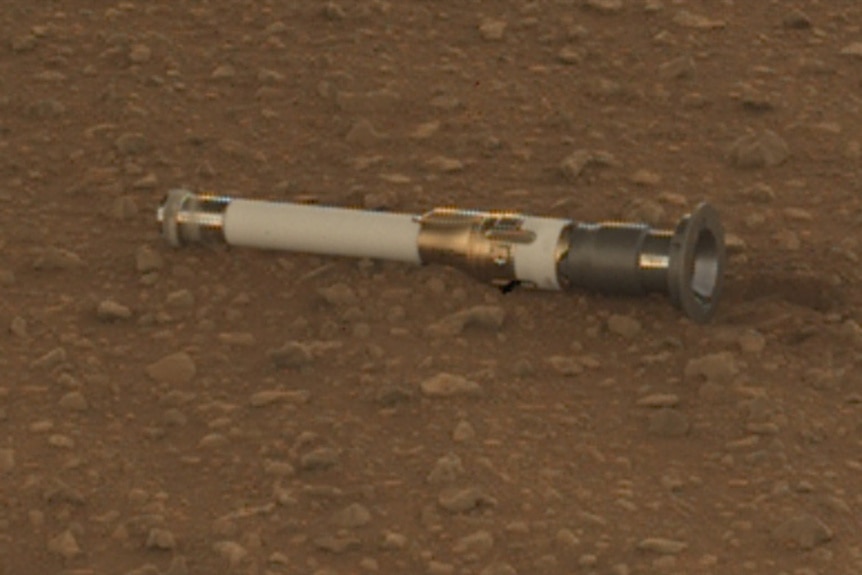Create a free profile to get unlimited access to exclusive videos, sweepstakes, and more!
Scientists Are Holding Their Breath for Samples of Fresh Martian Air
Perseverance has been collecting samples of Martian rock and air, now we just need to bring them home.
If we lived in the fictional town of Patience, Colorado, we could learn all about alien worlds by talking with Harry Vanderspeigle (Alan Tudyk), the titular Resident Alien (now streaming on Peacock). In the real world, if we want to learn about alien worlds, we have to go there ourselves, or at least send our machines.
For decades, NASA and other space agencies around the world have been sending spacecraft to Mars to study it. Some of them orbit and study Mars from a distance while others cut through the thin Martian air to land on its surface. NASA’s Perseverance rover launched July 30, 2020, from Cape Canaveral, Florida, and landed at Jezero Crater, Mars, about seven months later on February 18, 2021.
Since then, Perseverance has been exploring its little corner of the Red Planet and collecting samples for a future return mission to Earth. Over the last couple of years, the affectionately nicknamed Percy has collected two dozen rock cores and piles of Martian regolith (the Martian equivalent to dirt) and stored them inside metal tubes for eventual recovery.
Scientists hope those rock samples will reveal new and exciting information about the Martian past, perhaps even confirming the existence of ancient alien life. But scientists are also excited to get their hands on the Martian air surrounding the rock inside each sample tube.
For More on Mars:
A Mission to Mars Could Destroy Astronauts’ Kidneys
Morning Frosts Fill Martian Volcanoes with 150,000 Tons of Water Ice
The ESA's ExoMars Orbiter Captures Swarms of Dark "Spiders" on the Surface of Mars
Scientists Want to Look at the Martian Air Surrounding Perseverance's Rock Samples
A few years back, NASA’s OSIRIS-REx mission successfully visited the asteroid Bennu, touched down and collected a sample, and returned the sample capsule to Earth. Taking place in the vacuum of space, asteroid sample return missions like OSIRIS-REx only collect rock, but Mars has an atmosphere, thin as it might be. Those samples also contain alien air.
Each sample tube has a little bit of headspace and any air around the rock sample gets captured along with it. When and if those samples make it home, it will be the first time scientists will be able to directly study the Martian atmosphere in a lab. We know that the Martian atmosphere is almost entirely made of carbon dioxide, but the samples could reveal other trace gasses, unlocking new information about the evolution of the Red Planet.
“The air samples from Mars would tell us not just about the current climate and atmosphere, but how it’s changed over time. It will help us understand how climates different from our own evolve,” said Brandi Carrier, a planetary scientist at NASA’s Jet Propulsion Laboratory in Southern California, in a statement.
In addition to the tubes holding rock and air, there is one tube entirely filled with Martian air. That will give scientists an opportunity to study pristine air, but also air that has interacted with the rock samples inside the tube for years between capture and return. That air will also allow Earth scientists to see how dust particles interact, how big they are, and how toxic they might be. That’s all information that will be vitally important for any future crewed missions to Mars.
At present, it’s unclear when or if those samples will ever make it to Earth. The current plan involves multiple launches, putting a specialized Mars ascent vehicle (MAV) on the surface, and using rovers or helicopters like Ingenuity to collect the samples and bring them to the MAV. An assessment of the plan concluded it would take too long and be too expensive, so NASA is looking for alternatives.
Recently, the administration approved 10 studies from a collection of internal agencies and commercial partners, to look at faster and more affordable ways to get the samples back. “Mars Sample Return will be one of the most complex missions NASA has undertaken, and it is critical that we carry it out more quickly, with less risk, and at a lower cost,” said NASA Administrator Bill Nelson, in a statement. “I’m excited to see the vision that these companies, centers and partners present as we look for fresh, exciting, and innovative ideas to uncover great cosmic secrets from the Red Planet.”
Speaking of great cosmic secrets, Resident Alien is streaming now on Peacock!




































